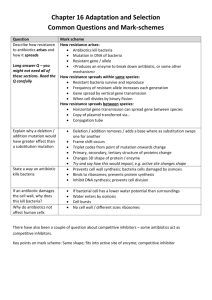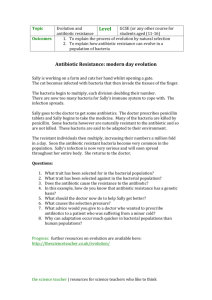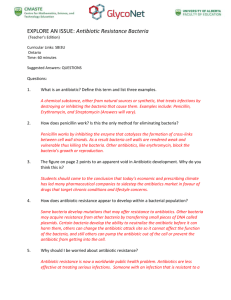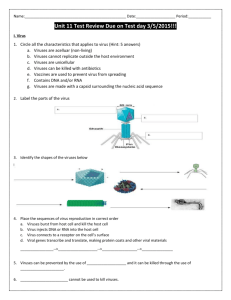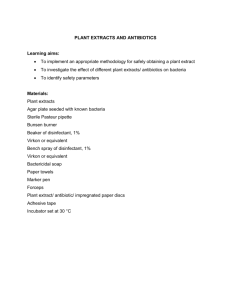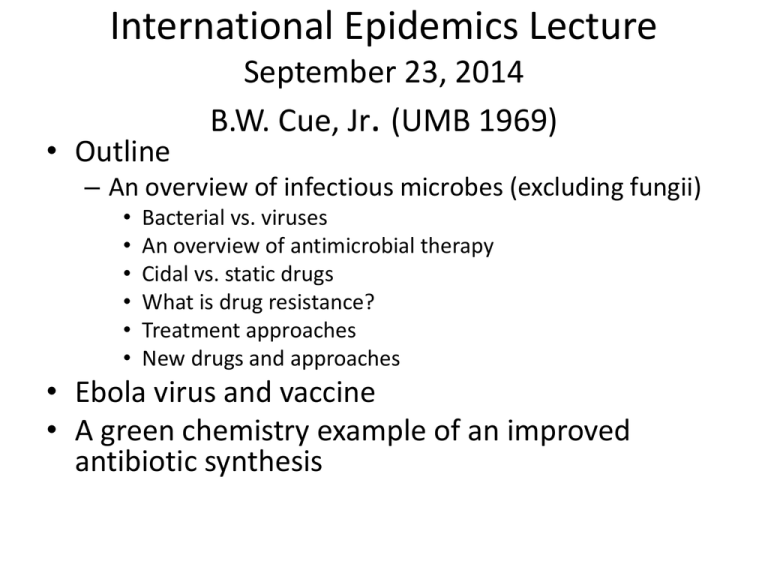
International Epidemics Lecture
• Outline
September 23, 2014
B.W. Cue, Jr. (UMB 1969)
– An overview of infectious microbes (excluding fungii)
•
•
•
•
•
•
Bacterial vs. viruses
An overview of antimicrobial therapy
Cidal vs. static drugs
What is drug resistance?
Treatment approaches
New drugs and approaches
• Ebola virus and vaccine
• A green chemistry example of an improved
antibiotic synthesis
An overview of infectious microbes (excluding
fungii)
Bacteria or Virus?
Source: Wikipedia
Bacteria or Virus?
Source: Wikipedia
An overview of antimicrobial therapy
Cidal vs. static
What is drug resistance?
Treatment approaches
Cidal vs. Static Drugs
• Bacteriocidal
– This kind of drug kills all susceptible bacteria
• Bacteriostatic
– This kind of drug inhibits/slows the growth of
bacteria until host’s immune system takes over
What causes drug resistance?
• Bacteria can become resistant to antibiotics by
mutating (changing) their genes after being in
contact with an antibiotic
– These changes allow the bacteria to survive or ‘resist’
the antibiotic.
• Bacteria can also develop resistance through
contact with other bacteria Resistant bacteria can
pass their genes to other bacteria, forming a new
antibiotic resistant ‘strain’ of bacteria.
– Resistant strains can spread to and infect other
people
What causes antibiotic resistance?
• The more antibiotics are used, the more chances
bacteria have to become resistant to them.
• Major causes of antibiotic resistance include
using antibiotics when they are not needed
• not taking antibiotics at the doses and times that
a doctor prescribes — this allows time for the
bacteria in your system to become resistant.
• Antibiotics are also often overused in animals (in
veterinary medicine and in agriculture).
You can help prevent antibiotic
resistance
• understanding that most people don’t need antibiotics
for colds and flu because they are caused by viruses
• telling your doctor you only want an antibiotic if it is
really necessary
• taking the right dose of your antibiotic at the right
time, as prescribed by your doctor
• taking your antibiotics for as long as your doctor tells
you to taking simple steps to avoid infections and
prevent them from spreading
• Properly disposing of unused/unwanted antibiotics
Source: CDC Report, Antibiotic Resistance
Threats in the United States, 2013
New drugs and approaches
New systemic antibacterial agents approved by the US Food and Drug Administration per 5year period, through 2012.
Boucher H W et al. Clin Infect Dis. 2013;cid.cit152
© The Author 2013. Published by Oxford University Press on behalf of the Infectious Diseases
Society of America. All rights reserved. For Permissions, please e-mail:
journals.permissions@oup.com.
GAIN legislation
The first new beta lactamase inhibitor
in 30 years
Beta Lacatmase Inhibitors
Sulbactam CP-45899
MK-7665 Relebactam
NDA Approval 2015?
Bacteriophages
Ebola virus and vaccine
See 2014 ICAAC Video for presentations about the
current Ebola outbreaks in Africa
http://www.icaac.org/
Zmapp Vaccine
• ZMapp is an experimental
biopharmaceutical drug
comprising three humanized
monoclonal antibodies under
development as a treatment
for Ebola virus disease.[1]
• The drug was first tested in
humans during the 2014 West
Africa Ebola virus outbreak
and was credited as helping
save lives, but it has not been
subjected to a randomized
clinical trial to prove its safety
or its efficacy.
Source: Wikipedia
A green chemistry example of an
improved antibiotic synthesis
Chemical Process for Semi Synthetic
Penicillins
Bio Synthetic (Greener) Process for
Semi Synthetic Penicillins


